— His final act: a scorching ‘farewell letter’ to the Catholic Church
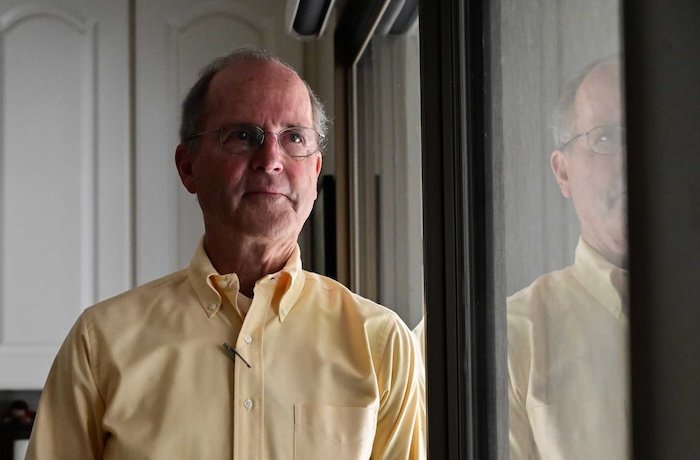
By Rachel Swan
He spent 17 years as a priest in exile, railing against what he said were the misdeeds and cover-ups of the Roman Catholic Diocese of Oakland, until the Vatican finally cut him loose in March.
Months later, Tim Stier delivered his final salvo: a scorching “farewell letter” that condemned several bishops, criticized the Catholic clergy for retrograde attitudes toward gender equity and LGBTQ civil rights, and cited specific allegations of sexual abuse that Stier says the church ignored or tried to conceal.
His missive became a new flare-up for an institution grappling with public controversies over abortion and civil rights, and with the fallout from a painful history of abuse that has jolted parishes throughout the country.
“Dear No-Longer-Fellow Priests,” it began, “this will likely be my farewell letter to most of you, which may be glad tidings to those of you who did not enjoy hearing from me.”
In recent interviews with The Chronicle, Stier reflected on the blistering critique he wrote and distributed widely, an apogee to nearly two decades of protest, penned four months after his defrocking on March 19.
The ousted priest counts himself among a small community of early whistleblowers who have tried to persuade Catholic clergy to atone for past wrongs and to pull the church into modern times.
“If you speak out on these issues, you’re going to be crushed,” Stier said.
A spokesperson for the Oakland diocese did not respond to specific allegations in Stier’s letter, but sent a statement to The Chronicle about his ouster.
“We wish Mr. Stier all the best in this new chapter in his life,” the statement read. “The process by which the pope removes a man from the clerical state, which you reference as the ‘defrocking process,’ is extensive and thorough. Therefore, it can take considerable time.
“You’ll need to ask Mr. Stier why he made the decision to abandon his priestly vows and ministry many years ago.”
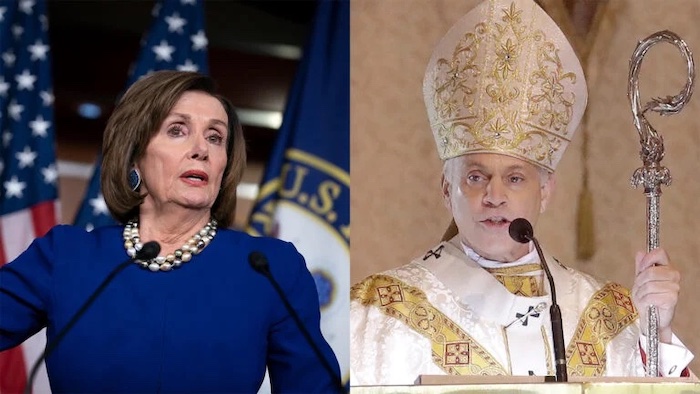
Tension between church leaders who wish to preserve rigid doctrine and parishioners who want a more open dialogue has been playing out in the largely liberal Bay Area. San Francisco Archbishop Salvatore Cordileone, who previously served as bishop in Oakland, recently denied communion to House Speaker Nancy Pelosi, a San Francisco Democrat, saying she must renounce her support of abortion rights.
Pelosi later received communion during a trip to the Vatican last month.
By standing up against the system, Stier speaks for a majority of Catholics who support LGBTQ rights and the ordination of women and denounce sexual abuse, said Marianne Duddy-Burke, executive director of DignityUSA, an organization that advocates for equal treatment of all of the faithful in the Catholic church.
Most of the nation’s 433 active and retired bishops follow the official teaching that gay and lesbian relationships are “objectively disordered,” and some have passed policies against the use of pronouns that don’t reflect the gender a person was assigned at birth, Duddy-Burke said.
She views Stier as a symbol at a moment of upheaval in the Catholic church — an outlier among diocesan priests, many of whom behave as “company men,” intent on ascending the hierarchy. Yet the positions Stier represents are “very valid and well within the Catholic mainstream,” Duddy-Burke said, even if the average parishioner or clergymember does not feel empowered to express them.
Over the years, Stier said, “I would get cards and letters from priests supporting what I was doing. I invited them to come (demonstrate) on Sunday mornings, but none of them were willing to risk that.”
He said a system committed to top-down authority, mandatory celibacy and the subordination of women’s voices may have to collapse before it can evolve. The church’s resistance to change may be its undoing, he said, “either through bankruptcies” from lawsuits “or disgrace.”
Stier has cast himself as an agitator from within, sustaining his Catholic faith even as he published op-ed pieces about the alleged hypocrisy of the church, or picketed outside Oakland’s cathedral on Sundays, with signs that demanded inclusion and structural reform.
“He’s been very consistent from the beginning about what his views were,” Stier’s friend, Margery Leonard, said.
Leonard, a retired teacher, met Stier when he served as pastor of Corpus Christi, her parish in Fremont, during the 1990s. Even then, he was outspoken, she said, delivering homilies that applied scripture to contemporary issues, such as homelessness or racial diversity, and trying to engage clergy in discussions about over-eating and alcoholism among priests.
“The clergy are very efficient at giving directions, but it’s just not a democratic group,” Leonard said.
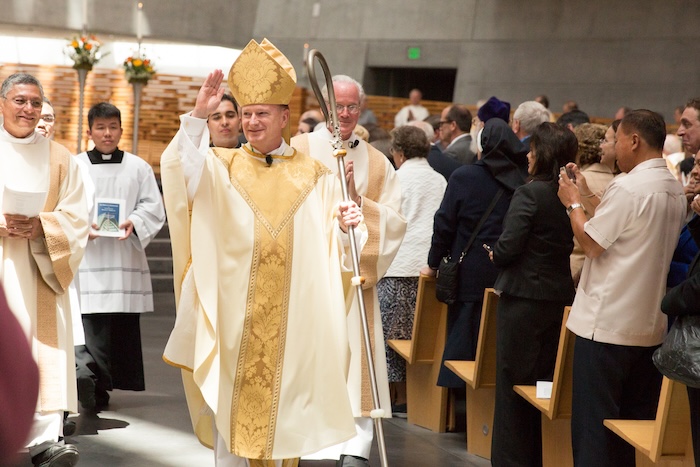
She became an ally of Stier during his two decades on the margins, after he became disillusioned with the church and refused a parish assignment from Bishop Allen Vigneron in 2005.
At the time, Stier said, he insisted that Vigneron publicly confront “three issues roiling the Church”: the sexual abuse of minors by clergy and bishops’ efforts to hide it; the refusal to ordain women and treat them equitably; and the cruel treatment of LGBTQ parishioners “based on an outdated theory of human sexuality.”
The diocese “didn’t know what to do with me,” Stier said. “They were hoping I’d come back. I was a well-respected, competent pastor.”
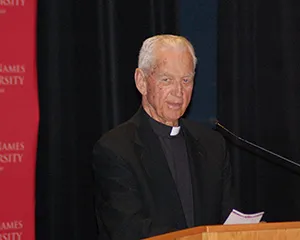
He surmised that Barber was embarrassed by the public crusade, and by Stier’s demand for Barber to “hold accountable” retired Bishop John Cummins, who had ordained Stier in 1979, but who Stier later accused of abetting sexual abuse of minors by moving predatory priests from one parish to another.
Representatives of the Archdiocese of Detroit, where Vigneron now serves as archbishop, declined to comment, deferring to their counterparts in Oakland. Attorneys for Cummins did not return phone calls, and a spokesperson for the Oakland diocese declined to comment on the retired bishop’s behalf.
Stier cited several examples in his letter of priests who served during Cummins’ tenure and who the Oakland Diocese subsequently deemed “credibly accused of sexual abuse by a minor.” One of them, Stephen Kiesle, pleaded no contest to charges of lewd conduct in 1978, for allegedly tying up and molesting two boys at Our Lady of the Rosary Parish in Union City, where he was a priest and teacher.
Two years ago, one of Kiesle’s alleged victims sued him, the diocese and Cummins, claiming the retired bishop knew Kiesle was a danger to children but allowed him to work with them anyway. The suit is part of a coordinated action involving more than a hundred plaintiffs against various dioceses and other church entities, with the first case set to go to trial next year, said Kiesle’s lawyer, Mark Mittelman.
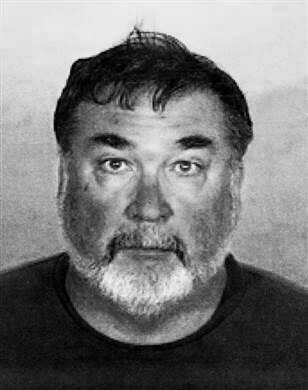
Separately, Kiesle was arrested this year on charges of killing a pedestrian while allegedly driving drunk in a Walnut Creek retirement community. He was freed on $250,000 bail in April and the case is pending.
Stier succeeded Kiesle at Our Lady of the Rosary in 1979, the year he was ordained. At the time, parishioners informed him of Kiesle’s misconduct, he said, but he heard nothing from the pastor or the diocese.
“It was so secretive in those days,” he told The Chronicle, noting that, before 1979, he had no inkling that priests had used their position to victimize others.
In interviews, Stier pointed to two factors that motivated him to write the letter. The first, he said, was a desire for closure. Second, he wanted to leave a record “of what I learned during my 17 years of voluntary exile from active priesthood,” working with abuse survivors and other people he views as marginalized by the archdiocese.
Once he’d finished and signed the missive, he printed out copies and mailed them to 60 priests. Fifty-nine didn’t respond; one sent a short, polite acknowledgment.
This month the letter appeared on BishopAccountability.org, a website and database that tracks alleged abuse by clergy.
The nonprofit Survivors Network of Those Abused by Priests, or SNAP, defended and praised Stier in a statement.
“It is ironic that a priest who showed integrity has been defrocked for taking a stand for what he believes is just,” the statement read, “while priests who molested children were hidden, paid and never forced to leave the church.”
Complete Article ↪HERE↩!
Cleveland Catholic Diocese should release more names, child-abuse victims’ advocate groups say
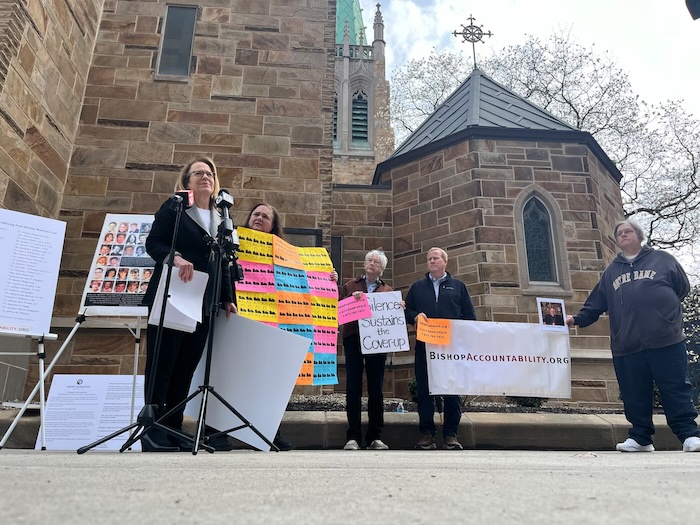
Release more names and more information. That was the call from victims advocates to the Catholic Church in Cleveland. The recent revelation of a former St. Ignatius priest being credibly accused of abusing children has sparked one organization’s deeper dive into priests who’ve served in the Cleveland Catholic Diocese.
Anne Barrett Doyle is the co-director of BishopAccountability.org. She stood in front of the Downtown cathedral today saying dozens of additional names of priests should be on the Cleveland Catholic Diocese credibly accused list. One of the names is a priest who we broke the story on last year.
“It’s hard to trust people,” said Tammie Mayle in tears just last year in a News 5 exclusive investigation. At the time, she had just filed a lawsuit saying while she was a child at the former orphanage called Parmadale, Father John Leahy abused her.
“(He) guided another child and myself to have sexual acts…in front of him and three or four other males,” she said in the interview.
“These are secrets that the diocese knows or should know,” said Barrett Doyle, who announced today that she has found 50 names, many of whom are on other dioceses’ lists across the country, that should be included on the Cleveland list. One of her names is Leahy.
“The case of Reverend John Leahy is a perfect example of the damage that (current diocese leader) Bishop Malesic is doing with his silence about abuse,” she told us.
Barrett Doyle said Bishop Edward Malesic is not doing enough to inform the community. She said in contrast, the Jesuits recently released information about Father Frank Canfield at St. Ignatius High School and the credible allegations against him, even providing a frequently asked questions section on its site.
She told us Cleveland deserves transparency. “I want this to be a place where kids are protected, where victims are honored and validated,” said Barrett Doyle.
Claudia Vercellotti, from the organization Survivors Network of those Abused by Priests or SNAP, said there are up to 145 more priests who were in Cleveland that could be named.
“Give a full, unabridged accounting of all credibly accused clerics, volunteers, staff members,” said Vercellotti. “It’s not just the sexual predator. It’s those who knew or should have known and provided cover.”
We went straight to the diocese offices to get their side of the story. No representatives came out to answer our questions on camera.
“This is information that belongs to the victims, that belongs to the families of the victims, that belongs to the faithful of Cleveland,” said Barrett Doyle.
The faithful, like Mayle, said it’s not as simple as just forgetting about the abuse she endured.
“How often do you think of that?” we asked.
“My whole life,” Mayle responded.
The list of the 50 names released today can be found on the site BishopAccountability.org.
The Cleveland Catholic Diocese released this statement in response to today’s news conference:
“The Catholic Diocese of Cleveland is steadfastly committed to the protection and safety of children, as demonstrated in its robust policies regarding background checks, its education and training, its commitment to reporting all allegations of child sexual abuse to civil authorities, and by the fact that no cleric in the Diocese of Cleveland against whom a substantiated allegation has been made is permitted to ever again serve in ministry.
The Diocese also makes public the names of any cleric who has been accused of child sexual abuse, regardless of when the alleged conduct took place or whether the accused is alive or deceased, provided the allegation is substantiated.
This list does not include non-diocesan clergy (clerics serving other dioceses) or clerics who belong to a religious order, only clerics of the Diocese of Cleveland.
For more comprehensive information on how the Diocese of Cleveland reports and compiles these lists and to view the current list, please visit our website.”
Complete Article ↪HERE↩!
Survivors of clergy sex abuse tell their stories before bankruptcy court and Archbishop William Lori, Baltimore officials
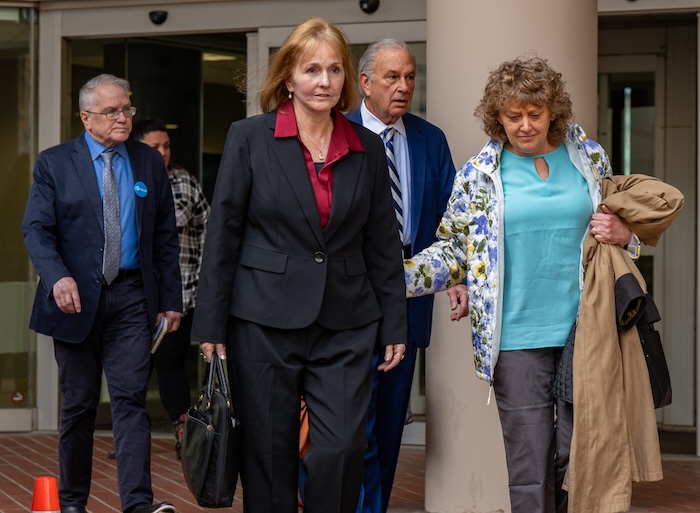
Six victim-survivors of sexual abuse by clergy in the Archdiocese of Baltimore gave statements in court April 8 about the long-term impact of the abuse on their lives as part of the federal bankruptcy reorganization.
The testimonies were off the record and not transcribed. Judge Michelle M. Harner, who is overseeing the Chapter 11 case, noted that the statements are not evidentiary in the case.
Their primary purpose, she said, was to “increase engagement and understanding” and to provide a forum for those affected by the pre-bankruptcy conduct of the archdiocese and its representatives.
“Today is a listening session and an opportunity for individuals to be heard,” Harner said.
Archbishop William E. Lori and Auxiliary Bishop Adam J. Parker attended the hearing, sitting in the front of the courtroom. They both hugged the first survivor who spoke.
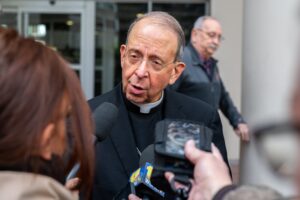
Harner thanked each person who made a statement — three women and three men — for their participation in the process. About 50 people attended the hearing at the federal courthouse in Baltimore.
Some of those who spoke to the court specifically addressed the archbishop. In one poignant moment, one of the victim-survivors also turned to address other victim-survivors in court, reminding them that as adults, they can take control of their healing.
Some common themes emerged in the victim-survivors’ statements — further abuse, troubled marriages and divorces, issues of trusting anyone, and other problems that have plagued their lives. Some noted that the chance to bring their experience to the court would be an important part of their healing.
In one touching moment, during one victim-survivor’s statement, the woman who was first to speak reached over the handrail to hold the hand of her husband, sitting just behind her.
The session, scheduled for two hours, ended after just an hour. Another such session is scheduled for May 20, which Archbishop Lori also will attend.
Paul Jan Zdunek, who chairs the Unsecured Creditors Committee, a group of seven people who represent all the victim-survivors in the case, said after the session that he was surprised at how quickly the session went, “despite it didn’t feel that way. I thought everyone was really great with their words and their preparation and the courage that it took to do that in front of everybody.”
He said he appreciated that the judge supported the process and allowed each participant to have the time they needed to tell their story.
“We even heard from them that this was a healing moment and a moment they’ve been waiting for in some cases 50 years, which is extraordinary. I think what struck me today was beyond the moments that happened when they were children, how much it has affected them since, you know, 50 years ago, 60 years of a life gone,” Zdunek told the Catholic Review, Baltimore’s archdiocesan news outlet.
He said he was not surprised to hear that many of those who spoke have issues trusting others, especially because the abuse happened in a church or school by someone who was supposed to minister to them. “Here it is the one place that you’re supposed to be safe and have been told, you know, as a Catholic raised myself, that this is the truth, the light, the way, the place for salvation — and to have that be the place that trust leaves you is devastating,” Zdunek said.
In advance of the hearing, he said the members of the survivors committee — five of whom attended the hearing — purposely wanted to allow others not on the committee to have the first opportunity to speak in court. He said that in this process, the committee already has the ear of the archbishop. “We thought it was important for others to really have the chance to speak.”
He expects the May 20 hearing to be similar. “He wanted to see how this went first, but I’d imagine it’s not going to be too much different than this.”
The deadline to file a claim in the case is May 31.
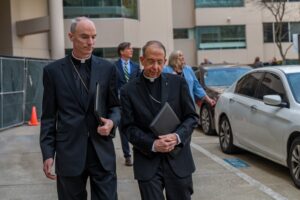
Teresa F. Lancaster, one of those who spoke in court, addressed reporters after the hearing and noted that she had testified in support of the Child Victims Act passed by the Maryland General Assembly in 2023, which removed the statute of limitations for civil suits for child sexual abuse.
She acknowledged that abuse has happened not just in the church, but also in other schools and organizations.
Asked whether her day in court was a day that she has long been waiting for, Lancaster, who eventually became an attorney so she could help other victims, said, “We wanted our day in court and we were deprived of it. So, I felt somewhat, and I want all the survivors to feel that, hey, your voice has been heard, you’re just as important, and people know what happened now.”
Outside the courthouse after the hearing, Archbishop Lori said he came as a pastor and priest and was moved by the testimony that he heard.
“My meetings with victim-survivors over the years have taught me the importance of their being able to tell their story, the importance of being heard and listened to, and being believed, and so I came to listen,” he said, adding that he “hopes that by doing this I can contribute in some small way to the healing of the of these individuals and what they’ve been through.”
He said that after the passage of the Child Victims Act, the archdiocese filed for Chapter 11 reorganization “so that we could, in fact, help as many victim survivors as equitably as we can while at the same time carrying forward the mission of the church, of our parishes, our charities and our schools.”
Asked if he has said he is sorry for the pain experienced by those abused, the archbishop said, “I’ve said it many times. and will say it to the end of my life. But I recognize that no apology of mine undoes what was done. Listening, believing, does a lot more.
“I’ve listened and met with victim survivors for a long, long time and every time I listen, it shakes me — every time.”
In a statement released later in the day, Archbishop Lori said, “I am deeply grateful to the victim-survivors for their courage today and I am moved by their heart-rending experience.
“To the victim-survivors who long to hear that someone is sorry for the trauma they endured and for its life-altering consequences: I am profoundly sorry. I offer my sincerest apology on behalf of the archdiocese for the terrible harm caused to them by representatives of the church,” he said. “What happened to them never should have occurred. No child should ever, ever suffer such harm.”
He added his thanks to those of Harner, saying, “I ask that the focus today be on the courage and bravery of the women and men who offered their statements and those they represent.
“Their stories and those of the victim-survivors I’ve met with privately for decades, emboldens our response and determination to ensure no child in our care is ever again harmed. I am grateful to the Survivors Committee for initiating the request to offer victim-survivors this opportunity today, which I sincerely pray will further assist them in their journey toward healing.”
The hearing comes a year and three days after the Maryland Office of the Attorney General released an extensive report on clergy sexual abuse of minors in the Archdiocese of Baltimore. Maryland Gov. Wes Moore, a Democrat, signed the Child Victims Act into law April 11, 2023. It went into effect Oct. 1, 2023.
Complete Article ↪HERE↩!
An Argentine judge recognizes gender abuse suffered for years by 20 nuns in a breakthrough ruling
— The ruling in the homeland of Pope Francis cast a spotlight on the long-standing of abuse of nuns by priests and bishops in the Catholic Church.
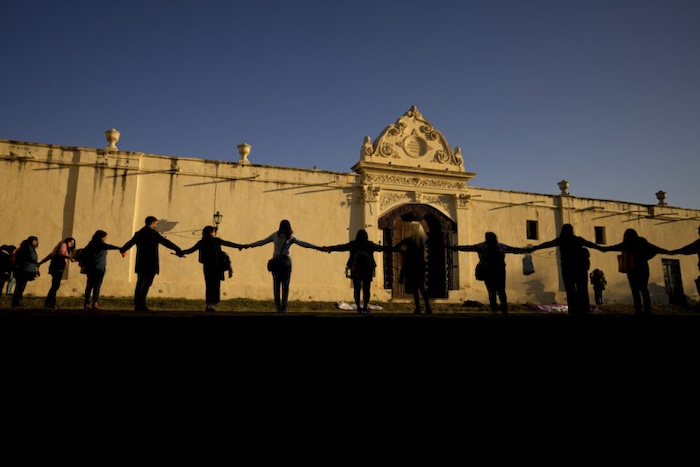
An Argentine judge on Friday ruled that 20 cloistered nuns had suffered abuse for more than two decades at the hands of high-ranking clergy in the country’s conservative north, and ordered the accused archbishop and church officials to undergo psychological treatment and training in gender discrimination.
The ruling in the homeland of Pope Francis cast a spotlight on the long-standing of abuse of nuns by priests and bishops in the Catholic Church.
Though long overshadowed by other church scandals, such abuses in religious life are increasingly being aired and denounced as a result of nuns feeling emboldened by the #MeToo movement, which has a corollary in the church, #NunsToo.
“I conclude and affirm that the nuns have suffered acts of gender violence religiously, physically, psychologically and economically for more than 20 years,” Judge Carolina Cáceres said in the ruling from Salta in northwestern Argentina.
She also ordered the verdict be conveyed to Francis.
The four accused clergy members have denied committing any violence. The archbishop’s lawyer, Eduardo Romani, dismissed Friday’s ruling as baseless and vowed to appeal. Still, he said, the archbishop would abide by the order to receive treatment and anti-discrimination training through a local NGO “whether or not he agrees with its basis.”
The nuns’ lawyer hailed the verdict as unprecedented in Argentina in recognizing the plaintiffs’ plight and the deeper problem of gender discrimination.
“It shatters the ‘status quo’ because it targets a person with a great deal of power,” said José Viola, the lawyer.
In recent years, several prominent cases have emerged involving nuns, laywomen or consecrated women denouncing spiritual, psychological, physical or sexual abuse by once-exalted priests.
But complaints have largely fallen on deaf ears at the Vatican and in the rigid all-male hierarchy at the local level in Argentina, apparently prompting the nuns in Salta to seek remedy in the secular justice system. A similar dynamic played out when the clergy abuse of minors scandal first erupted decades ago and victims turned to the courts because of inaction by church authorities.
The 20 nuns from the reclusive order of Discalced Carmelites at San Bernardo Monastery — dedicated to solitude, silence and daily contemplative prayer — brought their case forward in 2022, sending shockwaves through conservative Salta.
Their complaints cited a range of mistreatment including verbal insults, threats, humiliation and physical — although not sexual — assault.
The nuns describe archbishop Mario Cargnello as grabbing, slapping and shaking women. At one point, they said, Cargnello squeezed the lips of a nun to silence her. At another, he pounced on a nun, striking her as he struggled to snatch a camera from her hands. They also accused Cargello of borrowing nuns’ money without paying them back.
Cáceres, the judge, described the instances as “physical and psychological gender violence.”
Complete Article ↪HERE↩!
The Oblates and the geographic solution to clergy sexual abuse
— Despite the failures of the geographical solution to clergy sexual abuse, Catholic religious orders as the Oblates have a long record of using it.

By Rodolfo Soriano-Núñez
The Oblates have used the “geographical solution” before. One of their predator priests spent time in Mexico back in the Sixties.
Religion and Public Life: Argentina, Canada, France, Mexico, Paraguay, and the United States are among the countries where the Oblates have on the basis of the “geographic solution” to clergy sexual abuse.
Two weeks ago, Los Angeles Press published a report on the arrival of a Paraguayan Roman Catholic priest, a member of the Oblates of Mary Immaculate religious order, from his native country to Mexico.
At the time of the report, I’ve been in Mexico for at least six months. He’s got a low profile. There is no record of him participating as a priest in public functions carried out by the order.
After arriving to Mexico, Juan Rafael Fleitas López performed as an instructor at the schools where the Oblates train their so-called scholastics, which is how Catholic religious orders such as the Oblates call what other would be identified as seminarians: young students who aspire to become full members of the order and, in some cases, to become priests.
He was, in that regard, a pristine example of the so-called .geographic solution, which is an analyst how the forty-years-old clergy sexual abuse crisis in the Catholic Church call the decision by some orders and even some diocesan bishops to move around priests with accusations of sexual abuse from one diocese to and another, if allowed, from one country to another.
One of the many examples of the “geographical solution” is, in Mexico and the United States, the way in which Norberto Rivera Carrera and Roger Michael Mahony, moved around from one country to the other and back again, Nicolas Aguilar Rivera, who at some point was point aptly called by the media in the native state of Puebla – a state-wide shame.
Norberto Rivera first sent Nicolas Aguilar Rivera (no family relationship with the Cardinal) from Tehuacán, 260 kilometers or 160 miles East of Mexico City, in the state of Puebla, to Los Angeles, California, during his first stint as bishop. Roger Mahony was, at the time, the almighty cardinal and archbishop of the largest Catholic diocese in the United States, with more than three million souls under his care.

Aguilar Rivera was some sort of early revelation of the depth of the clergy sexual abuse crisis in Mexico back in the late 1980s, when this issue was kept concealed by the Roman Catholic hierarchy, and both the Mexican government and media.
Since I was able to move around from Tehuacán, a mid-size metro area in the Central state of Puebla, Mexico, to Los Angeles, California, and then back to Mexico, Aguilar is one of the most notable super-predators in the Mexican Catholic Church. Far from his crimes, both Norberto Rivera and Roger Mahony, provided the perfect settings and cover up for his actions.
The Archdiocese of Los Angeles paid almost $13 million as compensation. Although only Aguilars victims in that district of the U.S. Catholic Church received the monies.
Victims for the hundreds
There is no official information as if some payments were made by the Mexican dioceses of Tehuacán, Puebla, or Mexico City, which had, at some point in time competence over Aguilars performance as a priest in Mexico, although he is known that some of his received some of his victims some sort of compensation as a way to prevent the scandal brought by the fact that Cardinal Rivera was called to testify in California, as they could be seen in this transcript of his declaration from 2007.
Back in 2007, U.S. and Mexican media estimated Aguilars victims as at least ninety minors. I’ve repeatedly challenged that number, but there’s no reason to believe his word, since he was able to move around between both countries.
In Mexico, he was able to move officially between at two least Catholic dioceses: Tehuacán and Mexico City, although the last reports about his active life, from the mid to late aughts, about duties performing as a priest in the State of Mexico, the Mexican state surrounding Mexico City, which has had the largest number of separate dioces since the early 1990s.

Because of the .geographical solution, Aguilar was able to find new unsuspecting victims, every time his bosses in the Catholic hierarchy decided the spin of the wheel of fortune, giving him a new chance as even priest if he was not ever appointed as pastor of a parish after Mahony received him with a temporary appointment back in 1987.
It was only in 2009, more than 20 years after the first accusations against Aguilar emerged, that Pope Benedict XVI expelled him from the priesthood. Only then, the Mexican Catholic bishops publicly admitted that Aguilar was a predator sex. Although there was no official admission as to the number of his victims in either Mexico or the United States, Mexican newsmagazine Proceso estimated them in .more than a hundred minors.
And even if apologies have been issued by the three reigning Popes as to the extent and consequences of clergy sexual abuse, and many leaders of the Catholic Church mimic the reigning Pope-s rhetoric on the issue, at a global scale, the fact: there is an impulse to move priests with accusations of different types of sexual misconduct as a way to give them a second, third, or fourth chance in the exercise of the priesthood, with little or not for the potential consideration of risk of moving.
The fact that I rushed to publish my findings as to the potential destination of Juan Rafael Fleitas López as an associate priest in the parish of St. Mary Magdalene in Tequisistlán, Oaxaca, was to prevent new abuses.
It was necessary since it is no record of a current active interest of the Mexican Catholic hierarchy on addressing the issue, as it proved by the fact that less than half the Mexican dioceses have set up a commission to prevent abuses, as it proved last week on these pages.
Even more, since there is no indication that the current Mexican federal government will pursue the accusations made by survivors, their friends, and advocates back in 2017.
Changing of the guard
In that regard, my sources on the issue tell me that Fleitass appointment fell to Tequisistlán fell apart, although he spent time there in March, when other parishes managed by the Oblate order had changes of the pastors serving them. The most recent of such changes at the diocese of Tehuantepec, Oaxaca, was March 4th.
The changing of the guard happened at San Pedro Martir Quiechapa, as told by the entry at the Oblates official Facebook account that appears immediately after this paragraph or here.
After that, on March 23rd, the Oblates had a change in management at the parish of Christ Our Lord and Savior, at the diocese of Iztapalapa in Eastern Mexico City, as told by this entry from the same official Facebook reported immediately after this paragraph.
So, this is the season when the Oblates shuffle their priests from one parish or work to another. This is a healthy practice that forces priests and other religious personnel to confront new challenges and figure out new ways to do their work. It is not these regular changes that constitutes the practice of the .geographic solution to the issue of clergy sexual abuse.
Moreover, the Oblates are not new at using the .geographical solution to move around the priests and religious brothers who have faced accusations of sexual abuse. There is a long record of that order moving around priests and religious brothers from one of their provinces to another, to either cover up for the sexual abuse already perpetrated by some of them or as some sort of preventative measure, when one higher figures out that something is wrong with one of their subordinates in one of their provinces.
Even if Bishop is not seen as an accurate representation of whatever has happened as far as the clergy sexual abuse crisis in the Catholic Church on a global scale, since it has been a clear, even if undesired bias for the information coming from the English-speaking Catholic world, in their pages it is possible to find information that accurately depicts how, at least in the English- andspeaking Spanish-speaking Catholic worlds, the .geographical solution has been used by the Oblates and many other Catholic religious orders to move around priests with accusations of sexual misconduct.
More than Sixty Oblates
In that regard, Bishop Accountability has identified in one of its pages a minimum of 59 Oblates priests accused of clergy sexual abuse in U.S. and Canadian dioceses. On the top of that, in the Spanish-speaking pages of the same website there is information about one more Oblate, Luis Sabarre, originally from the Philippines but acting as a priest in the archdiocese of Mendoza, Argentina.
Also, there is information about at least two other members of this religious order, Gustavo Ovelar and Francisco Bareiro. The story linked above, the first of this series on the Oblates, mentions Bareiro and the impact of the accusations on him have. Both Ovelar and Bareiro are Argentine nationals. The Paraguayan newspaper La Nación described them back in 2016 as they are hiding out in Paraguay. That newspaper mentioned the fact that they were accused in 2014 of sexual assault.
A second Spanish-speaking page referenced at Bishop Accountability details how up until 2020, the Oblates kept their silence regarding the whereabouts of Ovelar and Bareiro.
What is worse. The English-speaking database of Bishop Accountability added data recently about the abuse perpetrated by French Oblates Edouard Meillieur and Johannes Rivoire in French and English-speaking missions in Canada going all the way back to the 1950s. Both are also representatives of the “geographical solution” as practiced by the Oblates.

It is noticeable that the statement issued by the Canadian province of the Oblates seems to be aware of the need to use the right words when talking about the pain brought by members of the order to their victims and the communities they were supposed to be serving.
The statement issued by the leader of the Oblates in Canada, Father Ken Thorson, reads “the Oblates” recognize the tragic legacy of clergy abuse and are sincerely committed to support the Inuit Peoples who advocate for truth, justice, healing and reconciliation.
How could it be that if the Canadian Oblates seem to be aware of the “tragic” consequences of the .geographic solution, used by the French and Canadian provinces of that order back in the 20th century, the Mexican and Paraguayan leaders of the same orders are so willing to put the Mexican faithful at risk of being abused by Juan Rafael Fleitas López?
That is the saddest aspect of the institutional neuroses affecting the Catholic Church nowadays.
Predator Priest
What is worse, in the English-speaking database available at Bishop Accountability, it is possible to find information about one predator priest moving from the United States to the very same diocese of Tehuantepec, Oaxaca, where the leaders of the province of the Mexican province tried to reinstate Fleitas López as they preside with the blessing of bishop Crispín Ojeda Márquez, the former auxiliary and none other than Cardinal Norberto Rivera Carrera.
I used the term “predator priest” knowingly and accurately. Bishop Accountability renders a short bio of Donald L. Stavinoha as he was killed back in 2007 but convicted in 1988, although the Texas authorities released him in 1991.
It is not clear if he assaulted or abused somebody at Tehuantepec, Mexico. We know, through a story published back in 1992 by Texan newspaper The Houston Chronicle, that I spent some time there between the late 1960s and early 1970s, when Jose de Jesús Clemente Alba Palacios was the bishop of Tehuantepec.
Oddly enough, Alba Palacios resigned his position as bishop of Tehuantepec back in 1970, when he was only 60 years old. Pope Paul VI appointed him auxiliary of the Archdiocese of Oaxaca, a strange move for a Roman Catholic bishop. Was it because of them then were issues related to abuse in Tehuantepec? God only knows.
As I am typing this story there is no official news about the destination of Juan Rafael Fleitas López. I know his appointment at Tequisistlán, diocese of Tehuantepec, fell apart, but there is no warranty that the leaders of the Oblate order in Mexico will not try to send him to any of his other parishes.
The only thing I know, for sure, is that Fleitas Lopez will not go back to be a priest at parish the Oblates have in Tijuana, Baja California. Although parish is in Mexico, it is not for the Mexican Oblates to decide who goes there. It is the Oblates of the United States who manages that parish as a “mission territory” in Mexico (see here and here too).
If Fleitas Lopez did something, it would be the Oblates in the United States, and under the laws of the United States would be liable. How lucky is the Mexican Catholic faithful of Tijuana, protected by U.S. Laws…
Complete Article ↪HERE↩!
